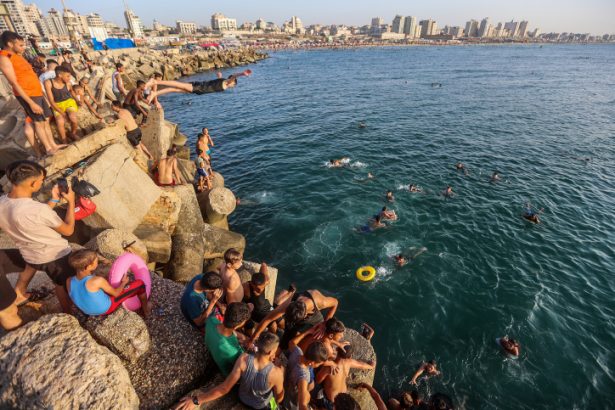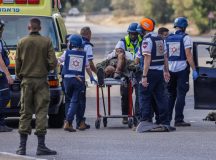Michael Rubin is Director of Labour Friends of Israel. He argues here for an urgent international plan for ‘Gaza after Hamas’, aimed at fostering peace, stability and prosperity, proposing an ambitious policy framework that will demand much from Israeli and Palestinian political leaderships, Western and Arab states, and the international community, but can offer a better future for two traumatised peoples.
Decent people of all political parties, all faiths, and all nationalities are united in their outrage at the actions of Hamas. We rightly share solidarity with the people of Israel, are horrified by the stories of the victims and demand immediate freedom for the captives, and above all the children. We share in affirming Israel’s right to defend itself against this terrorism, understanding that if Hamas appears to emerge a victor from this conflict, this will also embolden its allies Hezbollah and Iran.
We see too that the suffering of Palestinian civilians in the Gaza Strip is immeasurable. They are entitled to protection and aid, and the legal safeguards of humanitarian law. They too are victims of Hamas.
But support for Israel’s right to self-defence is not enough. Israel’s friends and allies must face, and must help Israel to face, the toughest of questions: How can we ensure that the destruction of Hamas’s murderous means – its weapons, its tunnels and its commanders – serves a long-term goal to defeat its murderous ideas?
We urgently need an international consensus around a plan for a post-Hamas Gaza. This plan must offer an alternative political order that prevents Hamas’s resurgence and also marginalises its ideology. In promoting this, Western powers can draw on their own historical experience – including the history of defeating murderous extremism in Europe – that shows that winning the peace is no less important that winning the war.
Defeating Hamas, and also the causes of Hamas
7 October clarified the challenge both for Israel and for international observers who want a better future for Israel and Palestinians. Once it was possible to debate whether Hamas had the capacity for moderation; whether it might, like the PLO before it, move away from the commitment to eliminating Israel and accept international parameters for ending the conflict. Or whether the responsibility of governing would make Hamas a pragmatic actor that could be accommodated.
The events of 7 October ended that debate. Hamas was always capable of the most vicious violence and bloodthirsty incitement. In suicide bombings in the 1990s and during the Second Intifada it always aimed for maximum civilian casualties. The opportunity to govern that it seized when it won a Palestinian legislative election in 2006, and then violently ousted the PA rivals in 2007, did not lead ultimately to moderation.
A comprehensive plan to defeat extremism must address the conditions that feed it. The sadistic perpetrators of 7 October are drawn from a generation who have grown up knowing nothing but rule by Hamas. They have been indoctrinated and radicalised under the Hamas authorities. This process is reinforced by a wider Islamist movement that impacts every part of the Arab world. Hamas’ decision to prioritise its genocidal war against Israel over the welfare of the people of Gaza has resulted in a deeply impoverished territory of more than two million people, half under the age of 15, with inadequate basic infrastructure or services, barely any economic opportunities, and limited options to go elsewhere. In these conditions Hamas had free rein to incite, recruit, train and arm its cadres from an enormous pool of prospectless young men.
Nor can the quest to destroy Hamas be pursued without reference to the wider political situation. For far too long there has been no credible hope for improvement. Hamas was not willing to hand Gaza back to the PA, but nor was there hope for realising a better future for Palestinians through a diplomatic process between the PA and Israel.
The weakness of the PA as a moderate alternative to Hamas has much to do with its own internal corruption and weak leadership. Its aging leader, Mahmoud Abbas, repeatedly spurned opportunities to develop a diplomatic horizon during the Obama Administration. But Israel must accept its share of the responsibility. Rather than working to build the credibility of the PA as an alternative to the Jihadist extremism of Hamas, Benjamin Netanyahu did the opposite: undermining hopes for an equitable two-state solution by promoting plans for annexation and building a coalition with the Israeli far-right in order to hang on to power. Netanyahu apparently saw no need to empower moderate alternatives to Hamas. Contrast that approach with the efforts, led by Benny Gantz and Yair Lapid, to do so during the sadly short-loved ‘unity government’ during 2021-22.
Now, however, the choices are clearer. They are clearer for those in the West who wanted to believe Hamas could be reasoned with. They are clearer for those in Israel who thought Hamas could be contained and the Palestinian issue sidelined.
Now we all know Hamas must be defeated.
Israel’s supporters are right to take the lead of Joe Biden: supporting Israel’s right to act militarily, whilst insisting on humanitarian supplies entering the Gaza Strip and that the use of force is deployed in accordance with international law and humanitarian principles. Within these parameters, it will ultimately be for Israeli decision makers to determine their approach.
But international actors can, and indeed must, play an active role in the wider effort to rehabilitate the Gaza Strip, and to create a political order to replace Hamas and ensure it can never return.
Winning the peace
It is important to act now to develop an international consensus on what should replace Hamas, that can gain acceptance among Palestinians, in Israel, and regionally.
This should not wait. Even among those who support the goal of removing Hamas, a grinding conflict that is not directed towards a clearly defined political goal will lead to fatigue, division, and calls for a ceasefire or settlement that leaves Hamas in place, and potentially emboldened. After each previous round of conflict and ceasefire (including 2009, 2012, 2014, 2021), Hamas has entered the next round with greater capabilities. This includes a greater range and quantity of rockets, and new capability for ground incursions, as well as improved defensive capabilities, including an estimated 500km of network of tunnels and bunkers under Gaza (a territory just 40 kilometres long and 10 kilometres wide).
The danger of Hamas emerging from this conflict with a ceasefire that enables them to retain effective control of the Strip, is that they will again have the capacity to develop their capabilities, and will also gain further prestige for themselves and their sponsors and allies, including in Tehran.
Israelis have understandably been more focussed on absorbing the shock and grief of their loss, and deciding on a military plan to destroy Hamas, than on designing political outcomes. Israeli governments, with all their ideological diversity, are unable to build consensus on the Palestinian issue even during peace time.
But Israel’s allies, including the US, and policy analysts within Israel, are increasingly aware that to be successful, a military strategy must be directed towards a clear political target. International observers have already started to sketch the outlines of a plan for post-Hamas Gaza.
It is clear that only a Palestinian-led government can secure the legitimacy from the Palestinian population and Arab states necessary for a stable future. The Palestinian Authority – which has retained a limited role in the Gaza Strip’s governance from the West Bank even in years since the Hamas takeover – must not be circumvented.
But the Palestinian Authority has lost credibility with Palestinians and struggles to govern those areas of the West Bank supposedly under its control. Publicly its leaders declare that they will not return to the Gaza Strip on top of an Israeli tank. Privately they may see the Gaza Strip as an unmanageable burden.
Some have therefore suggested that a Palestinian-led technocratic ‘Gaza Interim Administration’, linked to the PA but autonomous, should bridge between the status quo and the full reunification of the West Bank and Gaza under the PA. This echoes proposals made by Ibrahim Eid Dalalsha of the Ramallah-based Horizon Centre for Political Studies and Media Outreach and published by LFI in a paper last year for an internationally backed interim Palestinian administration to replace Hamas in the Gaza Strip, facilitate accelerated economic development, and prepare for future elections.
Whatever the details of a new Palestinian administration, it will need massive international support. Like-minded Western and Arab states, all with an overwhelming interest in defeating Islamist extremism and denying a victory to the Iran-led axis, will have to form the core of this mission, with an international stabilisation presence on the ground. Some have proposed a UN-mandated international mission comparable to the NATO mission supporting the local government in Kosovo.
International peace keeping and state building missions have a difficult history in the Middle East. The idea of a UN-mandated mission may call to mind the uninspiring example of UNIFIL in south Lebanon. Despite being beefed-up to 10,000 international troops after the 2006 ‘Second Lebanon War’ between Israel and Hezbollah, and backed by a UN mandate, the mission has not prevented Hezbollah acquiring an enormous arsenal of rockets with which to threaten Israel, including precision guided missiles.
The failures of multinational stabilisation and state building missions in Iraq and Afghanistan also loom large for Western policy makers. In Iraq, ‘debaathification’ – the removal from office of every official associated with the former ruling Baath party – left a catastrophic governance vacuum.
But the Gaza Strip is not a hopeless case. It is a small territory, bordered by just two states – Israel and Egypt – with a shared interest in promoting a stable and moderate Palestinian government. It has also had international agencies like UNRWA, as well as the PA, involved in administration and service provision even during Hamas’s rule.
Moreover, plans for revitalising Gaza have been pored over for years by development agencies and donor countries. These include expanding water desalination; piping gas from Israel to Gaza; developing Gaza’s own offshore gas fields; upgrading energy and communications infrastructure; establishing sea access; and creating new industry and employment opportunities, and even tourism.
The reconstruction costs after the seven-week conflict in 2014 were estimated at close to $4 billion. A UN-led Gaza Reconstruction Mechanism (GRM) facilitated the import of more than three million tonnes of building materials; the reconstruction of 10,000 homes; and major infrastructure projects.
But the more ambitious plans have moved at snail’s pace because of the complexity of internal Palestinian divisions; of navigating Israel and Egypt’s strict border regime; of coordinating with Hamas – a proscribed terrorist group and a national security threat to Israel and Egypt; and the slow trickle of donor assistance.
Gulf States in particular failed to follow through on their generous post-war pledges. Moreover, the GRM clearly did not fulfil one of its key functions, to prevent Hamas diverting huge quantities of building materials to its military infrastructure.
However, if Hamas were to be toppled, and a new Palestinian administration backed by an international mission established on the ground, many new opportunities open up.
The costs of reconstruction this time are likely to be even greater than in 2014. Many donor countries will despair at being asked to spend their taxpayers’ money on rebuilding Gaza again.
But there has never been a time in history when so many Arab states have been so heavily invested in making this work. These include Egypt and Jordan, the new peace partners UAE, Morocco and Bahrain, as well as Saudi Arabia. Mohammed Bin Salman has shown readiness to invest vast sums in improving Saudi Arabia’s image in the West and would like to create the basis for normalising relations with Israel.
Several of these countries have also shown that a culture of hate can be reformed, with remarkable examples of a top-down shift in discourse towards promoting tolerance and coexistence, and opposing Jihadism.
A supportive regional environment could in time help reinvigorate bottom up societal peace building efforts between Israelis and Palestinians, of the kind supported by the International Fund for Israeli-Palestinian Peace which LFI has long championed. It is hard to envisage grassroots peace and reconciliation whilst living through the bloodiest days of the Israeli-Palestinian conflict. But here too there are lessons to be learned from other cases. Whilst Northern Ireland is very different, it is worth noting that civic society peacebuilding began with the formation of the International Fund for Ireland (the model for the International Fund for Israeli-Palestinian Peace) during the darkest days of the conflict in 1986, some 12 years before the signing of the Good Friday Agreement. It is also worth noting that while $44 per person per year has been spent on civic society peacebuilding in Ireland, that figure drops to a mere $2 per person in Israel-Palestine.
The lessons of European history
There are other lessons that be drawn from European history. The second world war was of course a completely different conflict, yet whilst the total military defeat of Nazi Germany was necessary for expunging its murderous ideology, realising a sustainable peace required more. Just two years after the defeat of Germany, the US flooded parts of Europe under allied control with massive sums of reconstruction aid through the Marshall plan, with West Germany the largest recipient. This was followed soon after by the establishment of the Federal Republic of Germany under a new, democratic, German leadership. The newly constituted West Germany was then integrated into regional institutions – the European Community and NATO – in which it participated as a full member, albeit one with a sustained international military presence on its territory.
The most potent symbol of the allies’ triumph was not the tanks reaching Hitler’s bunker in 1945. It was 18 years later, when John F. Kennedy, who had almost been killed in the second world war, and whose older brother, and brother-in-law had been killed, went to Berlin and declared in German: ‘Ich Bin Ein Berliner’, to an adoring new generation of Germans, committed to liberal principles.
The situation in the Gaza Strip is, of course, very different. But in Gaza too, and in the wider Palestinian arena, the defeat of extremism must be accompanied by a peacebuilding strategy resting on four reinforcing pillars: an economic plan that gives hope to Palestinians of a decent life; a diplomatic horizon that maps out a credible route to the dignity and legitimacy of self-determination that is necessary for a stable political order; the integration of Palestinian state-building into the Arab-Israeli normalisation process; and in that context a deradicalisation strategy and the promotion of a culture of peace. This includes confronting the incitement and hatred that is rife not only in Palestinian social media, but in the education system of Hamas, and also the Palestinian Authority.
Israel’s role
Israel must be a full and committed partner to this. That is hard to envisage with the extremist nature of the current Israeli government, notwithstanding the welcome addition of Benny Gantz to the war cabinet.
From around 2015, Netanyahu stopped paying even lip-service to the two-state solution. Increasingly dependent on a right-wing base, and then far-right coalition partners to stay in power, he has dangled the prospect of an annexationist policy in the West Bank before hardliners on the Israeli right. Some of his far-right coalition partners have gone even further, inciting violence against Palestinians in the West Bank.
Palestinian support for a two-state solution, which was above 50 per cent as recently as 2017, has drained to less than 30 per cent, correlated with a drop in the belief in its feasibility and prospects. During the same period, Palestinian support for violence has risen.
But now domestic support for Netanyahu’s coalition is collapsing, even in the midst of an existential struggle. Netanyahu’s policy of containing Hamas and marginalising the Palestinians has been shattered. Down the line Israel is due a seismic political change which may bring a more moderate leadership. More than ever, national security will be at the top of Israelis’ agendas, but a new leadership may be capable of articulating a holistic and progressive approach to attaining it.
In a policy speech made as foreign minister in 2021, leader of the opposition Yair Lapid took the unusual step of articulating a vision for political change in the Gaza Strip. Lapid’s policy distinguished between two stages. In the first, in return for quiet, and with international oversight to prevent Hamas’ military build-up, Israel would support rehabilitation of water and electricity systems and reconstruction of housing and infrastructure. A second stage, linked to the restoration of PA authority, would see more game-changing projects, including an artificial island project to give Gaza a port, a transport link to the West Bank, and more ambitious economic projects with Israel and Egypt.
He reiterated the message in his speech as prime minister to the UN General Assembly in September 2022, declaring: ‘An agreement with the Palestinians, based on two states for two peoples, is the right thing for Israel’s security, for Israel’s economy and for the future of our children,’ and declared directly to the people of Gaza: ‘we’re ready to help you build a better life, to build an economy … We only have one condition: Stop firing rockets and missiles at our children.’
This is not the time to engage Israelis in any discussion that even hints at ceding elements of their security to Palestinians. But it is the time to talk about how to ensure Hamas can never return, by building up the credibility of a moderate Palestinian alternative.
Conclusion
In the midst of the most catastrophic conflict for Israelis and Palestinians since 1948, there are important messages Israel must hear from its friends. The first is solidarity: an unequivocal rejection of Hamas terror and any justification for it, an unceasing effort to return captives, and a clear understanding of the stakes of this conflict for Israel’s future. The second is a consistent reminder that respect for innocent lives in Gaza is the hallmark of a just war, and at the core of the values that bind Israel and its democratic allies. The third is that defeating Hamas ultimately requires more than military means. It requires a credible political vision for the future of the Gaza Strip, and a clear process towards a new political order based on Palestinian statehood alongside a secure Israel, that can secure legitimacy from Palestinians and the region.




































